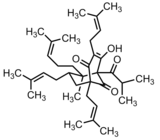Reuptake inhibitor

A reuptake inhibitor (RI) is a type of reuptake modulator which inhibits the plasmalemmal transporter-mediated reuptake of a neurotransmitter from the synapse into the pre-synaptic neuron, leading to an increase in the extracellular concentrations of the neurotransmitter and therefore an increase in neurotransmission. Various drugs to exert their psychological and physiological effects through reuptake inhibition, including many antidepressants and psychostimulants.[1]
Most known reuptake inhibitors affect the monoamine neurotransmitters serotonin, norepinephrine (and epinephrine), and dopamine.[1] However there are also a number of pharmaceuticals and research chemicals that act as reuptake inhibitors for other neurotransmitters such as glutamate,[2] γ-aminobutyric acid (GABA),[3] glycine,[4] adenosine,[5] choline (the precursor of acetylcholine),[6] and the endocannabinoids,[7] among others.[1]
Mechanism of action
Active site transporter substrates

Standard reuptake inhibitors are believed to act simply as competitive substrates that work by binding directly to the plasmalemma transporter of the neurotransmitter in question.[8][9][10][11] They occupy the transporter in place of the respective neurotransmitter and competitively block it from being transported from the nerve terminal or synapse into the pre-synaptic neuron. With high enough doses, occupation becomes as much as 80–90%. At this level of inhibition, the transporter will be considerably less efficient at removing excess neurotransmitter from the synapse and this causes a substantial increase in the extracellular concentrations of the neurotransmitter and therefore an increase in overall neurotransmission.
Allosteric site transporter substrates

Alternatively, some reuptake inhibitors bind to allosteric sites and inhibit reuptake indirectly and noncompetitively.
Phencyclidine and related drugs such as benocyclidine, tenocyclidine, ketamine, and dizocilpine (MK-801), have been shown to inhibit the reuptake of the monoamine neurotransmitters.[12][13][14] They appear to exert their reuptake inhibition by binding to vaguely characterized allosteric sites on each of the respective monoamine transporters.[15][16][17][18][19] Benztropine, fluoxetine, mazindol, and vanoxerine also bind to these sites and have similar properties.[15][19][20] In addition to their high affinity for the main site of the monoamine transporters, several competitive transporter substrates such as cocaine and indatraline have lower affinity for these allosteric sites as well.[17][19][20]
A few of the selective serotonin reuptake inhibitors (SSRIs) such as fluoxetine and the dextro-enantiomer of citalopram appear to be allosteric reuptake inhibitors of serotonin.[21][22] Instead of binding to the active site on the serotonin transporter, they bind to an allosteric site, which exerts its effects by causing conformational changes in the transporter protein and thereby modulating the affinity of substrates for the active site.[21] As a result, escitalopram has been marketed as an allosteric serotonin reuptake inhibitor. Notably, this allosteric site may be directly related to the above-mentioned PCP binding sites.[15][20]
Two of the primary active constituents of the medicinal herb Hypericum perforatum (St. John's Wort) are hyperforin and adhyperforin.[23][24] Hyperforin and adhyperforin are wide-spectrum inhibitors of the reuptake of serotonin, norepinephrine, dopamine, glutamate, GABA, glycine,[25] and choline,[26] and they exert these effects allosterically by binding to and activating the transient receptor potential cation channel TRPC6.[24][27] Activation of TRPC6 induces the entry of calcium (Ca2+) and sodium (Na+) into the cell, which causes the effect.[27]
Vesicular transporter substrates

A second type of reuptake inhibition affects vesicular transport, and blocks the intracellular repackaging of neurotransmitters into cytoplasmic vesicles. In contrast to plasmalemmal reuptake inhibitors, vesicular reuptake inhibitors do not increase the synaptic concentrations of a neurotransmitter, only the cytoplasmic concentrations; unless, that is, they also act as plasmalemmal transporter reversers via phosphorylation of the transporter protein, also known as a releasing agent. Pure vesicular reuptake inhibitors tend to actually lower synaptic neurotransmitter concentrations, as blocking the repackaging of, and storage of the neurotransmitter in question leaves them vulnerable to degradation via enzymes such as monoamine oxidase (MAO) that exist in the cytoplasm. With vesicular transport blocked, neurotransmitter stores quickly become depleted.
Reserpine (Serpasil) is an irreversible and competitive inhibitor of the vesicular monoamine transporter 2 (VMAT2), and is a prototypical example of a vesicular reuptake inhibitor.
Types
Agonistic
Typical
- Amino acid reuptake inhibitor
- Excitatory amino acid reuptake inhibitor (or glutamate-aspartate reuptake inhibitor)
- GABA reuptake inhibitor
- Glycine reuptake inhibitor
- Monoamine reuptake inhibitor
- Miscellaneous
Atypical
- TRPC6 activators (wide-spectrum reuptake inhibitors) – hyperforin, adhyperforin
Antagonistic
Plasmalemmal
Vesicular
- Vesicular acetylcholine transporter (VAChT) inhibitor – vesamicol
- Vesicular monoamine transporter (VMAT) inhibitor – reserpine, tetrabenazine
See also
References
- ^ a b c Iversen L. (2006). "Neurotransmitter transporters and their impact on the development of psychopharmacology". Br J Pharmacol. 147 (1): S82–88. doi:10.1038/sj.bjp.0706428. PMC 1760736. PMID 16402124.
- ^ West AR, Galloway MP (1997). "Inhibition of glutamate reuptake potentiates endogenous nitric oxide-facilitated dopamine efflux in the rat striatum: an in vivo microdialysis study". Neurosci Lett. 230 (1): 21–4. doi:10.1016/S0304-3940(97)00465-5. PMID 9259454.
- ^ Pollack MH, Roy-Byrne PP, Van Ameringen M, Snyder H, Brown C, Ondrasik J, Rickels K (2005). "The selective GABA reuptake inhibitor tiagabine for the treatment of generalized anxiety disorder: results of a placebo-controlled study". J Clin Psychiatry. 66 (11): 1401–8. doi:10.4088/JCP.v66n1109. PMID 16420077.
{{cite journal}}: CS1 maint: multiple names: authors list (link) - ^ Alberati D, Moreau JL, Lengyel J, et al. (February 2012). "Glycine reuptake inhibitor RG1678: a pharmacologic characterization of an investigational agent for the treatment of schizophrenia". Neuropharmacology. 62 (2): 1152–61. doi:10.1016/j.neuropharm.2011.11.008. PMID 22138164.
- ^ Boissard CG, Gribkoff VK (1993). "The effects of the adenosine reuptake inhibitor soluflazine on synaptic potentials and population hypoxic depolarizations in area CA1 of rat hippocampus in vitro". Neuropharmacology. 32 (2): 149–55. doi:10.1016/0028-3908(93)90095-K. PMID 8383814.
- ^ Barkhimer TV, Kirchhoff JR, Hudson RA, Messer WS (November 2002). <3699::AID-ELPS3699>3.0.CO;2-E "Evaluation of the inhibition of choline uptake in synaptosomes by capillary electrophoresis with electrochemical detection". Electrophoresis. 23 (21): 3699–704. doi:10.1002/1522-2683(200211)23:21<3699::AID-ELPS3699>3.0.CO;2-E. PMID 12432531.
{{cite journal}}: CS1 maint: multiple names: authors list (link) - ^ Costa B, Siniscalco D, Trovato AE, Comelli F, Sotgiu ML, Colleoni M, Maione S, Rossi F, Giagnoni G (2006). "AM404, an inhibitor of anandamide uptake, prevents pain behaviour and modulates cytokine and apoptotic pathways in a rat model of neuropathic pain". Br J Pharmacol. 148 (7): 1022–32. doi:10.1038/sj.bjp.0706798. PMC 1751928. PMID 16770320.
{{cite journal}}: CS1 maint: multiple names: authors list (link) - ^ Barker, Eric L.; Randy D. Blakely (1995). Norepinephrine and serotonin transporters: molecular targets of antidepressant drugs. In: Psychopharmacology: the fourth generation of progress.
- ^ Sur C, Betz H, Schloss P. (1998). "Distinct effects of imipramine on 5-hydroxytryptamine uptake mediated by the recombinant rat serotonin transporter SERT1". J Neurochem. 70 (6): 2545–2553. doi:10.1046/j.1471-4159.1998.70062545.x. PMID 9603221.
{{cite journal}}: CS1 maint: multiple names: authors list (link) - ^ Ravna AW, Sylte I, Dahl SG. (2003). "Molecular mechanism of citalopram and cocaine interactions with neurotransmitter transporters". J Pharmacol Exp Ther. 307 (1): 34–41. doi:10.1124/jpet.103.054593. PMID 12944499.
{{cite journal}}: CS1 maint: multiple names: authors list (link) - ^ Apparsundaram S, Stockdale DJ, Henningsen RA, Milla ME, Martin RS. (2008). "Antidepressants targeting the serotonin reuptake transporter act via a competitive mechanism". J Pharmacol Exp Ther. 327 (3): 982–990. doi:10.1124/jpet.108.142315. PMID 18801947.
{{cite journal}}: CS1 maint: multiple names: authors list (link) - ^ Pechnick RN, Bresee CJ, Poland RE (2006). "The role of antagonism of NMDA receptor-mediated neurotransmission and inhibition of the dopamine reuptake in the neuroendocrine effects of phencyclidine". Life Sci. 78 (17): 2006–11. doi:10.1016/j.lfs.2005.09.018. PMID 16288927.
{{cite journal}}: CS1 maint: multiple names: authors list (link) - ^ Nishimura M, Sato K, Okada T, Yoshiya I, Schloss P, Shimada S, Tohyama M (1998). "Ketamine inhibits monoamine transporters expressed in human embryonic kidney 293 cells". Anesthesiology. 88 (3): 768–74. doi:10.1097/00000542-199803000-00029. PMID 9523822.
{{cite journal}}: CS1 maint: multiple names: authors list (link) - ^ Nishimura M, Sato K, Okada T, Schloss P, Shimada S, Tohyama M. (1998). "MK-801 blocks monoamine transporters expressed in HEK cells". FEBS Lett. 423 (3): 376–380. doi:10.1016/S0014-5793(98)00126-4. PMID 9515743.
{{cite journal}}: CS1 maint: multiple names: authors list (link) - ^ a b c Akunne HC, Reid AA, Thurkauf A, Jacobson AE, de Costa BR, Rice KC, Heyes MP, Rothman RB. (1991). "[3H]1-[2-(2-thienyl)cyclohexyl]piperidine labels two high-affinity binding sites in human cortex: further evidence for phencyclidine binding sites associated with the biogenic amine reuptake complex". Synapse. 8 (4): 289–300. doi:10.1002/syn.890080407. PMID 1833849.
{{cite journal}}: CS1 maint: multiple names: authors list (link) - ^ Rothman RB, Reid AA, Monn JA, Jacobson AE, Rice KC. (1989). "The psychotomimetic drug phencyclidine labels two high affinity binding sites in guinea pig brain: evidence for N-methyl-D-aspartate-coupled and dopamine reuptake carrier-associated phencyclidine binding sites". Mol Pharmacol. 36 (6): 887–896. PMID 2557536.
{{cite journal}}: CS1 maint: multiple names: authors list (link) - ^ a b Goodman CB, Thomas DN, Pert A, Emilien B, Cadet JL, Carroll FI, Blough BE, Mascarella SW, Rogawski MA, Subramaniam S, et al. (1994). "RTI-4793-14, a new ligand with high affinity and selectivity for the (+)-MK801-insensitive [3H]1-]1-(2-thienyl)cyclohexyl]piperidine binding site (PCP site 2) of guinea pig brain". Synapse. 16 (1): 59–65. doi:10.1002/syn.890160107. PMID 8134901.
- ^ Rothman RB. (1994). "PCP site 2: a high affinity MK-801-insensitive phencyclidine binding site". Neurotoxicol Teratol. 16 (4): 343–353. doi:10.1016/0892-0362(94)90022-1. PMID 7968938.
- ^ a b c Rothman RB, Silverthorn ML, Baumann MH, Goodman CB, Cadet JL, Matecka D, Rice KC, Carroll FI, Wang JB, Uhl GR, et al. (1995). "Studies of the biogenic amine transporters. VI. Characterization of a novel cocaine binding site, identified with [125I]RTI-55, in membranes prepared from whole rat brain minus caudate". J Pharmacol Exp Ther. 274 (1): 385–395. PMID 7616423.
- ^ a b c Rothman RB, Cadet JL, Akunne HC, Silverthorn ML, Baumann MH, Carroll FI, Rice KC, de Costa BR, Partilla JS, Wang JB, et al. (1994). "Studies of the biogenic amine transporters. IV. Demonstration of a multiplicity of binding sites in rat caudate membranes for the cocaine analog [125I]RTI-55". J Pharmacol Exp Ther. 270 (1): 296–309. PMID 8035327.
- ^ a b Chen F, Larsen MB, Sánchez C, Wiborg O. (2005). "The S-enantiomer of R,S-citalopram, increases inhibitor binding to the human serotonin transporter by an allosteric mechanism. Comparison with other serotonin transporter inhibitors". Eur Neuropsychopharmacol. 15 (2): 193–198. doi:10.1016/j.euroneuro.2004.08.008. PMID 15695064.
{{cite journal}}: CS1 maint: multiple names: authors list (link) - ^ Mansari ME, Wiborg O, Mnie-Filali O, Benturquia N, Sánchez C, Haddjeri N. (2007). "Allosteric modulation of the effect of escitalopram, paroxetine and fluoxetine: in-vitro and in-vivo studies". Int J Neuropsychopharmacol. 10 (1): 31–40. doi:10.1017/S1461145705006462. PMID 16448580.
{{cite journal}}: CS1 maint: multiple names: authors list (link) - ^ Müller WE, Singer A, Wonnemann M (2001). "Hyperforin – antidepressant activity by a novel mechanism of action". Pharmacopsychiatry. 34 Suppl 1: S98–102. doi:10.1055/s-2001-15512. PMID 11518085.
{{cite journal}}: CS1 maint: multiple names: authors list (link) - ^ a b Chatterjee SS, Bhattacharya SK, Wonnemann M, Singer A, Müller WE (1998). "Hyperforin as a possible antidepressant component of hypericum extracts". Life Sci. 63 (6): 499–510. doi:10.1016/S0024-3205(98)00299-9. PMID 9718074.
{{cite journal}}: CS1 maint: multiple names: authors list (link) - ^ Marsh WL, Davies JA (October 2002). "The involvement of sodium and calcium ions in the release of amino acid neurotransmitters from mouse cortical slices elicited by hyperforin". Life Sciences. 71 (22): 2645–55. doi:10.1016/S0024-3205(02)02104-5. PMID 12354583.
- ^ Buchholzer ML, Dvorak C, Chatterjee SS, Klein J (May 2002). "Dual modulation of striatal acetylcholine release by hyperforin, a constituent of St. John's wort". The Journal of Pharmacology and Experimental Therapeutics. 301 (2): 714–9. doi:10.1124/jpet.301.2.714. PMID 11961077.
{{cite journal}}: CS1 maint: multiple names: authors list (link) - ^ a b Leuner K, Kazanski V, Müller M, et al. (December 2007). "Hyperforin – a key constituent of St. John's wort specifically activates TRPC6 channels". The FASEB journal : official publication of the Federation of American Societies for Experimental Biology. 21 (14): 4101–11. doi:10.1096/fj.07-8110com. PMID 17666455.
{{cite journal}}: CS1 maint: unflagged free DOI (link)
